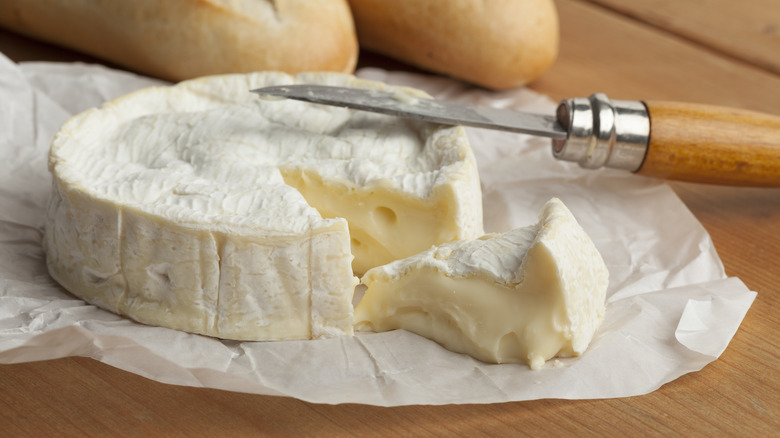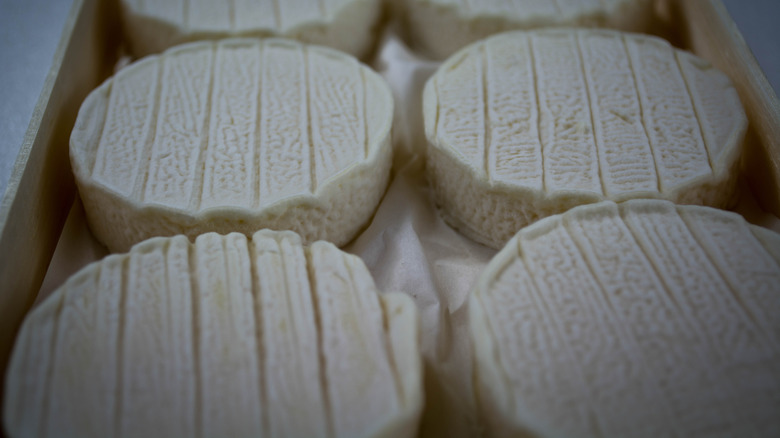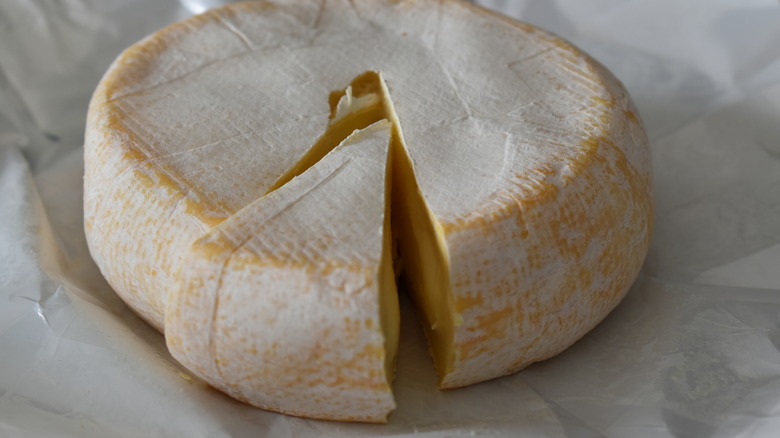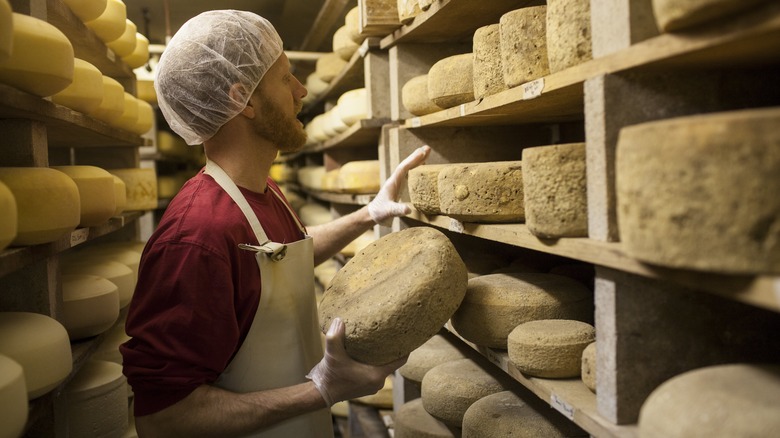What's The Deal With Raw Milk Cheese?
We're no strangers to unique cheeses and the people who appreciate them. Avante Garde charcuterie lovers, we're looking at you. If you're hungry to take a walk on the wild side and jump into a vat of runny Boursalt cheese (or if you're just looking for something different to pair with your wine), we're deep-diving into the world of Fromage iconoclasts. So, what's the deal with raw milk cheese?
Raw milk cheeses are softer, stinkier, gamier, and funkier than your average cheeses. "Terroir" is the name of the game here. They include Maytag Blue, Fourme D'Ambert, Vermont Shepherd, Bravo Cheddar, and countless others, per The Spruce Eats. Famously (or, perhaps infamously), all that pungent flavor doesn't come without a pretty big catch. The CDC names raw milk as "one of the riskiest foods," insisting that "no raw milk is safe." Yet, in his magnum opus "Kitchen Confidential: Tales from the Culinary Underbelly," chef Anthony Bourdain wrote, "I've long believed that good food, good eating, is all about risk. Whether we're talking about unpasteurized Stilton, raw oysters, or working for organized crime 'associates,' food, for me, has always been an adventure." So, which side is right? Is it fair or even reasonable to write off artisanal, raw milk cheeses as dangerous or unfit for consumption? Let's find out.
Unlike other cheeses, raw milk cheese takes a pass on pasteurization
Raw milk cheeses come from unpasteurized milk, says Cheesetique. Pasteurization is a process by which milk is heated for long enough to wipe out dangerous bacteria that might be lurking. According to Nevada Dairy Farmers, one of the most common types is "flash pasteurization," in which dairy is heated to 161 degrees Fahrenheit, kept there for at least 15 seconds, then quickly cooled back down to 39 degrees. The process kills harmful bacteria and gives the milk two or three extra weeks of shelf life. However, pasteurization neutralizes all the useful bacteria in milk as well – bacteria that help cheese age gracefully, and give cheeses their idiosyncratic characteristics.
Perhaps ironically, folks have been relying on the natural bacteria found in raw milk cheese for much longer than they have been afraid of it. Nomadic Middle Eastern tribes of 8000 B.C. were toting around kefir in the hot, hot sun, says Cheese Grotto. The natural heat-souring prolonged its shelf life. Raw milk cheese is actually regarded as cheese's original form. All cheese was technically raw milk cheese before the advent of pasteurization in 1822. Refrigeration wasn't around yet, either. Prior to the American Industrial Revolution, cheese-making was an activity for home cooks, crafting small-scale batches by hand in everyday kitchens.
Why raw milk cheese has accrued a cult following among foodies
Call it a "silent majority," or call it a "vocal minority." Whatever you call it, we're harkening back to chef Anthony Bourdain again, the unofficial Leader of the Raw Milk Cheese Fandom. In an episode of "A Cook's Tour," Bourdain visits Murray's cheese shop in NYC, proudly announcing, "If you know anything about me, you know one of my favorite things on this planet is stinky, runny cheese. The stinkier and the runnier, the better." Enter: Raw milk cheese. A Facebook post by Murray's shop recalled that he was especially fond of the "spicy and sweet" raw cheese Stichelton.
Cheesetique explains that bacteria separate one cheese from the next. They lend the distinct flavors, aromas, and textures that make your favorite cheeses unique – and those bacteria are allowed to stick around when the cheesemonger foregoes pasteurization. Raw milk cheeses tend to be less firm. Some are runny, crumbly, or creamy says The Spruce Eats. But, there are firm and semi-firm raw milk cheeses to be enjoyed, as well, all with dimensional flavors.
For all of its very real risks, raw milk cheese isn't without some solid health benefits. It's packed with probiotics, says Grassland Beef, and easier to digest. (In fact, says Livestrong, pasteurization might be a cause of lactose intolerance.) Raw milk cheeses can also pack more B vitamins and vitamin C than cheeses made from pasteurized milk.
A cheese banned overseas (and at home, too)
While raw milk cheese is a delicacy to some, it carries a reputation so controversial as to rival foie gras. Per the CDC, selling a gallon of raw milk to a cheese fanatic today is illegal in 23 U.S. states. In 1949, the FDA passed a law that all raw milk cheeses sold in the U.S. must be aged for at least 60 days prior to distribution, via Cheesetique. But, says Grassland Beef, there's no such rule in France. The Australian Government's Department of Agriculture says all raw milk cheeses require a "recognized foreign government certificate" to be legally imported into Australia. You won't find a single form of certified raw dairy in Nevada, says Nevada Dairy Farmers. Why is it so globally divisive?
Since raw milk foregoes pasteurization, it has the potential to carry harmful bacteria and pathogens that can make consumers sick, including E. coli, Listeria, Brucella, and Salmonella. Even healthy animals can still transmit germs through their milk. For this reason, raw milk cheese is a luxury that elderly, pregnant, or immunocompromised people should stay away from. Still, in the hands of a knowledgeable cheesemonger, raw milk cheese is nothing to fear. Adam Brock of the Dairy Farmers of Wisconsin testifies, "If a producer follows strict sanitation protocols and good manufacturing processes, the risk of getting sick from raw milk cheese is low," via Consumer Reports. (Enjoy at your own risk.)



